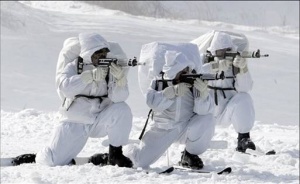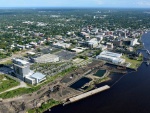Bylusia
| The Sovereign Confederacy of the Bylusian Peninsula of Bylusia | |||||
|---|---|---|---|---|---|
| |||||
| Motto: "Trust in yourself, your compatriots, and the Fatherland" | |||||
| Anthem: "Hymn of Umbragrad" | |||||
| Geography | |||||
| [[image:|225px|Location of Bylusia]] | |||||
| Area | 1.08 millionkm2 | ||||
| Water (%) | {{{water_area}}} | ||||
| Highest point | Mount Zekhy | ||||
| Longest river | Feliantis River | ||||
| Demographics | |||||
| Population | 6,200,000 | ||||
| • Density | {{{density}}}/km2 | ||||
| • Growth | {{{growth}}}%/year | ||||
| Median age | {{{median_age}}} years | ||||
| Demonym | Bylusian | ||||
| History | |||||
| Formation of the Modern States | 19 March, 1759
| ||||
| Constitution of the Confederacy | 5 September, 1917 | ||||
| Government | |||||
| Capital | Umbragrad | ||||
| Official language | Erovan | ||||
| Type | Elective Dictatorship | ||||
| Legislature | The Blackwood Committee | ||||
| Premier | Teuche Dullahan
| ||||
| State | Six States | ||||
| Economy | |||||
| Currency | GelbMark (¬) (GM) | ||||
| GDP | {{{GDP}}} | ||||
| • Per capita | {{{per_capita_GDP}}} | ||||
| • Growth | {{{GDP_growth}}}%/year | ||||
| Sectors |
19% Agriculture | ||||
| Unemployment | 6.9% | ||||
| Gini | {{{gini}}} | ||||
| Development | |||||
| Life expectancy | 74.3 years | ||||
| Improved water access | 98% | ||||
| Literacy | 99% | ||||
| Enrollment | 84.6% | ||||
| • Primary | 99.8% | ||||
| • Secondary | 98% | ||||
| • Tertiary | 56% | ||||
| Standards | |||||
| Measures | Metric | ||||
| Date format | Day-Month-Year | ||||
| Traffic | Right-hand | ||||
| Codes | |||||
| ISO code | BC | ||||
| Internet TLD | .bc | ||||
| Calling code | +51 | ||||
The Sovereign Confederacy of the Bylusian Peninsula, is a sparsely populated country in northwestern Ennorath. It is an elective dictatorship, comprised of a mostly homogenous population, made up of the native former city-states.
Contents
[hide]History
Bylusia is a tight knit confederacy of formerly independent city states, established by the predominant native clans. After centuries of internal struggle, the city-states individually expanded, filling in the previously unclaimed territory. Following the Great War, the peninsula was unified under the banner of Cenric Dolan, the Hero of Umbragrad, establishing the Bylusian Union Party as the predominant political power in the nation, where it has remained in power since. Prior to 1500, historical sources are few in number, however, historians have corroboarated multiple accounts indicating that the former nomadic clans, most notable of which are the Eruvingians, the Aemeve, the Threcians, the Orernii, and the Pallas. Following an initial exposure to an unknown Eastern faith, the Eruvingians, the genesis of the present-day state of Erova, rose to prominence, engaging in a swift, bloody conquest of it's neighbors. The victory was to be short-lived, as a schism in the new faith thrust the area into violent upheaval. This period of violent instability lasted for centuries, up into the 1700's. Toward the end of the 18th century, the states had taken the borders that up up to today, with the signing of the Bylusian Pact on 19 April 1799 showing the first spark of a unitied Bylusia. The 1800's would prove to be a renaissance in Bylusian culture, as the end of major feuding between the states would allow science, philosophy, medicine, and engineering to flourish. Bylusia would remain isolationist up until 1895, evolving at a surprising pace, up until the close of the century, when it would be swept into the conflict engulfing the world. While war raged in the East, whispers of war were brewing in the West .Neustrian Agents infiltrated the ranks of the West Erovan Militia, inflaming long dormant expansionist dreams and launched a war of conquest, reclaiming the territory that had left prior the Collapse. . From that point, the newly unified Erovan army swftly invaded its neighbors, Orernion, Amevion and Palloch. Palloch suffered greatly, as it had unofficially aligned with the Coalition, providing war materiel, unaware of the Neustrian proxy to the West. After failing to secure the eastern front, a massive Pro-Coalition insurgency broke out in the Erovan City of Shaleport. Pro Neustrian forces responded with impunity, purging Carth sympathizers in the streets, a crime that has scars up to today. This crackdown gave the Eastern States opportunity to regroup, leading up to a counter attack in Occupied Tercia. Tercia was liberated, at the cost of Palloch and Orernion, effectively splitting the Eastern Alliance in two. Erovan forces swept through Tercia, reclaiming the territory, and isolating Amevion, the last state on the peninsula. For a year and a half, Erovan forces laid siege to the province, painfully capturing town after town. Finally, only Umbragrad stood against the Erovan onslaught, leading to a a bloody siege that lasted for over a year.For 14 months, Umbragrad was shelled, sieged, bombed, and raided, but its citizens peresevered. Finally, at the war neared conclusion in the Far East, Neustrian support withered, leaving the Erovan army woefully under equipped, as Coalition sympathizers secured the Eastern border. The Breaking of the Siege of Umbragrad is perhaps the most significant event in the history of Bylusia, as for the first time in history, the peninsula unified behind a single leader. Dolan was elected Governor of Amevion at the tender age of 20, and in short time had annexed Orernion and Tercia. The first monumental task was the rebuilding of ravaged Palloch, before securing the Erovan lands. By the end of 1917, all of the Bylusia had unified under the Dolan's banner, and thus the Byulsian Unionist Party was born. Tensions continued between the newly christened Free Erova movement up into the 1970's climaxing in the Fall and Emancipation of Umbragrad, colloquially known as the Three Weeks War. Following the defeat of the Erovan Patriotic Front in 1972, Bylusia has seen a period of peace the like of which has not been seen since the 1800's
Government and politics
Bylusia is ruled by an elective dictatorship, headed by the Premier of the Blackwood Committee, named after the Blackwood Keep in Umbragrad. The Premier is chosen from among the Committee, by the Committee, and serves the nation for life. Membership in the Committee is either inherited, or as in the case of current Premier Teuche Dullahan, a citizen can be elevated to the Committee following a majority vote of confidence. Throughout its history, Bylusia has remained primarily isolatoinist in policy, focusing more on establishing stability and developing a thriving economy, carefully overseen by the Premier and the Committee.
Foreign relations and armed forces
Foreign relations
An isolationist nation up until the effects of the Great War, Bylusia has begun to open up to its neighbors, establishing trade relations as well as the pursuit of military alliance.
Military
The Bylusian Confederate Armed Forces are comprised of five components:
Bylusian Confederate Army -Bylusian Confederate Reserves Bylusian Confederate Air Force -Bylusian Civil Air Defense Corps Bylusian Confederate Navy
Military service age and obligation:
18-25 years of age for male and female compulsory military service recruits, with a minimum three year service requirement. 18-28 for commission applicants; 18-35 years of age for the Reserve Defense Forces
Confederate citizenship, refugee status, or 5-year residence in Bylusia required (2014)
The Bylusian government puts a great emphasis on defense, developing a respected, effective fighting force, a natural evolution for a nation steeped in war.
Law and criminal justice
The legal system is unique in Bylusia, given that each state maintains its own unique legal codes and edicts, all of which fall in compliance to Blackwood decree. Capital punishment is used in limited circumstances, under the assumption of a living body being of more value than a corpse. Legal proceedings are handled by the State Governor, who is elected by his constituency.
Geography
The Bylusian Peninsula is surprisingly varied, given its high latitude. Along the eastern border of West Erova, lie the Tetys Mountains, the highest of which is Mount Zekhy, at an altitude of 2474M. Bulk of the country is designated taiga or sub-tundra, making agriculture a marked challenge, to which the Bylusians have responded accordingly.
Climate
Bylusian's arctic location leads to lengthy, bitterly cold winters, followed by short, cool summers. Given it's coastal position, precipitation is surprisingly robust, and regular through the year.
Demographics
Population
While natives of the individual states will boldly declare the differences between the ethnicities of each state, centuries of isolationism have created a shockingly homogenous culture, marked by fair skin, dark hair, and coarse features.
| Largest metropolitan areas | ||||||
|---|---|---|---|---|---|---|
| # | City | Population | ||||
| 1 | Umbragrad | 1,527,060 (2010) | ||||
| 2 | Molosano | 895,360 | ||||
| 3 | Achenar | 327,600 | ||||
| 4 | Shaleport | 141,620 | ||||
| 5 | Priseph | 132,712 | ||||
| 6 | Olmene | 97,967 | ||||
Language
| Language | Percent of population |
Number of speakers |
|---|---|---|
| Erovan | 74.6% | 4,629,040 |
| Combined total of all languages other than Erovan |
25.4% | 1,570,960 |
Religion
Following the catastrophic effects of outside religion on the region, religion is largely a personal concern, the predominant faith being Deism, followed by agnosticism, and an Ozian minority. The Bylusian Pact denounced the choice of a state-sponsored religion,as well as discrimination based on faith. a decision that echoes today. Bylusians are free to practice what faith they like, so long as it doesn't infringe on another.
Economy
The Bylusian economy is state-capitalist driven, allowing for private enterprise under state scrutiny. Being given a single direction for the economy to work towards has been very effective in unifying the means of production as well as optimizing the workforce. Compulsory military service encourages the community mentality, making the Bylusian economy a force to be reckoned with, in spite of its diminuative scale.
Its primary exports include barley, small arms, light vehicles, and uranium.
Culture
Bylusian culture varies widely by province, in spite of a common background. The Erovan States share a fierce militant history, in contrast with the high culture of Amevion. Dolan Hall, the premiere learning institution, located in the capital of Umbragrad, has one of the world's foremost schools for philosophy, engineering, and military studies.






